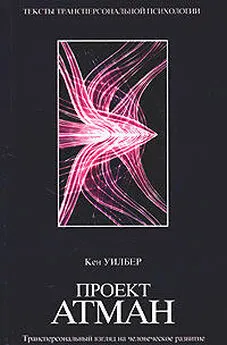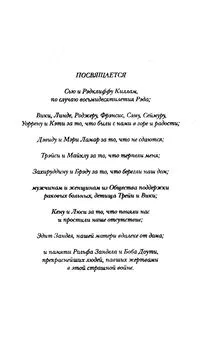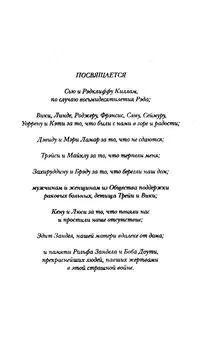Кен Уилбер - Проект Атман
- Название:Проект Атман
- Автор:
- Жанр:
- Издательство:Издательство АСТ
- Год:2004
- Город:Москва
- ISBN:5–17–021069–8
- Рейтинг:
- Избранное:Добавить в избранное
-
Отзывы:
-
Ваша оценка:
Кен Уилбер - Проект Атман краткое содержание
В книге одного из ведущих теоретиков трансперсональной психологии сопоставляются взгляды наиболее известных психологических школ и духовных традиций на эволюцию человека. Делается попытка аналитически разрешить проблему достижения всеединства — или проекта Атмана — как называет ее автор.
Издатели благодарят Алексея Купцова, чья финансовая помощь и дружеская поддержка сделали возможной публикацию этой книги. Перевод с английского под редакцией Александра Киселева Научный редактор кандидат философских наук Владимир Майков Серийное оформление Павла Иващука
© Ken Wilber, 1980
© Институт трансперсональной психологии, 2004
© Издательство К. Кравчука, 2004
© Оформление ООО «Издательство ACT», 2004
Тираж 3000 экз.
Проект Атман - читать онлайн бесплатно полную версию (весь текст целиком)
Интервал:
Закладка:
[117]. Fairbairn, W.. An object‑relations theory of the personality. New York: BasicBooks, 1954.
[118]. Farber, L. The ways of the will. New York: BasicBooks, 1945.
[119]. Federn, P. Ego psychology and the psychoses. New York: BasicBooks, 1952.
[120]. Fenichel, O. The psychoanalytic theory of neurosis. New York: Norton, 1945.
[121]. Ferenczi, S. Stages in the development of the sense of reality. In Sex and psychoanalysis. Boston: Gorham, 1956.
[122]. Ferenczi, S. Thalassa. New York: The Psychoanalytic Quarteque, 1938.
[123]. Ferenczi, S. Furter contributions to the theory and technique of psychoanalysis. New York: BasicBooks, 1952.
[124]. Festinger, L. Theory of cognitive dissonance. New York: Peterson, 1957.
[125]. Feurstein, G. A. Introduction to theBhagavad Gita. London: Rider, 1974.
[126]. Feurstein, G. A. Texbook of yoga. London: Rider, 1975.
[127]. Fingarette, H. The self in transformation. New York: BasicBooks, 1963.
[128]. Flugel, J. Man, morals and society. New York: International Universities Press, 1945.
[129]. Foulkes, D. A grammar of dreams. New York: BasicBooks, 1978.
[130]. Frank, J. Nature and Function ofbelief systems: humanism and transcendental religion. American Psychologist, vol. 32, 1977.
[131]. Frankl, V. Man’’s sears for meaning. New York: Washington Square, 1963.
[132]. Freemantle, F., and Trungpa, С The Tibetanbook of the dead. Berkeley: Shamabhala, 1975.
[133]. Fremantle, A. The Protestant mystics. New York: Mentor, 1965.
[134]. Freud, A. The ego and the mechanisms of defense. New York: International Universities Press, 1946.
Freud, S. The standard edition of the complete psychological work of Sigmund Freud. 24 volumes, translated and editedby James Strachey. London: Hogarth Press and the Institute of Psychoanalysis, 1953–1964.
[135]. Freud, S. The interpretation of dreams. Standard Edition, vols. 4 and 5.
[136]. Freud, S. Three essays on the theory of sexuality. Standard Edition, vol. 7.
[137]. Freud, S. Totem and taboo. Standard Edition, vol. 13.
[138]. Freud, S. On narcissism: an introduction. Standard Edition, vol. 14.
[139]. Freud, S. Beyond the pleasure principle. Standard Edition, vol. 18.
[140]. Freud, S. The ego and the id. Standard Edition, vol. 19.
[141]. Freud, S. Civilization and its discontents. Standard Edition, vol. 20.
[142]. Freud, S. New introductory lectures. Standard Edition, vol. 22.
[143]. Freud, S. An outline of psychoanalysis. Standard Edition, vol. 23.
[144]. Freud, S. A general introduction to psychoanalysis. New York: PocketBooks, 1971.
[145]. Frey‑Rohn, L. From Freud to Jung. New York: Delta, 1974.
[146]. Fromm, E. Escape from freedom. New York: Farrar, Straus, and Giroux, 1941.
[147]. Fromm, E. Psychoanalysis and religion. New York: Bantam, 1967.
[148]. Fromm, E., Suzuki, D. Т., and De Martino, R. ZenBuddhism and psychoanalysis. New York: Harper, 1970.
[149]. Gardner, H. The quest for mind. New York: Vintage, 1972.
[150]. Gebser, J. Ursprung and gegenwart. Stuttgart: Deutsche Verlags‑Ansalt, 1966.
[151]. Gebser, J. Foundations of the aperspective world. Main Currents, vol.29, no. 2, 1972.
[152]. Geertz, C. The interpretation of cultures. New York: BasicBooks, 1973.
[153]. Gendlin, E. Experiencing and the creation of meaning. New York: Free Press, 1962.
[154]. Giovacchini, P. Psychoanalysis. In Corsini, R., reference note #88.
[155]. Glasser, W. Reality therapy. New York: Pocket, 1974.
[156]. Globus, G. et al. (eds). Consciousness and thebrain. Plenum, 1976.
[157]. Goble, F. The third force. New York: Pocket, 1974.
[158]. Goffman, E. The presentation of self in everyday life. Garden City: Anchor, 1959.
[159]. Goldstein, K. The organism. New York: AmericanBook, 1939.
[160]. Goleman, D. The varieties of the meditative experience. New York: Dutton, 1977.
[161]. Govinda, L. Foundations of Tibetan mysticism. New York: Weiser, 1973.
[162]. Gowan, J. Trance, art, and creativity. Northridge, С A; 1975.
[163]. Green, E., and Green, A. Beyondbiofeedback. New York: Delacourte, 1977.
[164]. Greenacre, P. Certain relationshipsbetween fetishism and faulty development of thebody image. Psychoanalytic Study of the Child, vol. 8, 1953.
[165]. Greenson, R. The technique and practice of psychoanalysis. New York: International Universities Press, 1976.
[166]. Grof, S. Realms of the human unconsious. New York: Viking, 1975.
[167]. Group for the Advancement of Psychiatry. Mysticism: spiritual quest psychic disorder? New York: Group for the Advancement of Psychiatry, 1976.
[168]. Guenon, R. Man and hisbecoming according to the Vedanta. London: Luzac, 1945.
[169]. Guenther, H. Buddhist philosophy in theory and practice. Baltimore: Penguin, 1971.
[170]. Guenther, H. Treasures on the Tibetan middle way. Berkeley: Shambhala, 1971.
[171]. Guenther, H. Philosophy and psychology in the abhidharma. Berkeley: Shambhala, 1974.
[172]. Guenther, H. trans. The life and teaching of Naropa. London: Oxford Univ., 1963.
[173]. Guenther, H., and Trungpa, C. The dawn of tantra. Berkeley: Shambhala, 1975.
[174]. Hakeda, Y. S., trans. The awakening of faith. New York: Columbia Univ., 1967.
[175]. Hall, С A primer of Jungian psychology. New York: Mentor, 1973.
[176]. Hall, R. The psycho‑philosophy of history. Main Currents, vol. 29, no. 2, 1972.
[177]. Harrington, A. The immortalist. New York: Random House, 1969.
[178]. Harris, T. I’’m o.k. — you" re o.k. New York: Avon, 1969.
[179]. Hartmann, H. Ego psychology and the problem of adaptation. New York: International Universities Press, 1958.
[180]. Hartshorne, C. The logic of perfection. Ulinoes: Open Cout, 1973.
[181]. Heard, G. The ascent of humanity. London: Jonathan Cape, 1929.
[182]. Heidegger, M. Existence andbeing. Chicago: Henry Regney, 1950.
[183]. Heidegger, M. Being and time. New York: Harper, 1962.
[184]. Heidegger, M. Discourse on thinking. New York: Harper.
[185]. Hixon, L. Coming home. Garden City: Anchor, 1978.
[186]. Hocart, A. Social origins. London: Watts, 1954.
[187]. Holdstock, Т., and Rogers, C. Person‑centered theory. In Corsini, R., reference note #88.
[188]. Hood, R. Conceptual Criticisms of regressive explanations of mysticisms. Rev. Religious Res., vol. 17, 1976.
[189]. Hook, S. (ed.) Dimensions of mind. New York: Collier, 1973.
[190]. Horney, K. The neurotic personality of our time. New York: Norton, 1968.
[191]. Hume, R., trans. The thirteen principle Upanishads. London: Oxford, 1974.
[192]. Husserl, E. Ideas. New York: Macmillan, 1931.
[193]. Huxley, A. The perennial philosophy. New York: Harper, 1970.
[194]. Jacobi, J. The psychology of С G. Jung. London: Routledge and Kegan Paul, 1968.
[195]. Jacobson, E. The self and the object world. New York: International Universities Press, 1964.
[196]. Jakobson, R. Child language aphasia and phonological universals. Quoted in Gardner, reference note #149.
[197]. James, W. The principles of psychology, vols. 1–2. New York: Dover, 1950.
[198]. James, W. Varieties of religious experience. New York: Collier, 1961.
[199]. Jantsch, E., and Waddington, C. (eds). Evolution and consciousness. Addison‑Wesley, 1976.
[200]. Jaynes, J. The origin of consciousness in thebreakdown of thebicameral mind. Boston: Houghton Mifflin, 1976.
[201]. John of the Cross, St. Dark night of the soul. Garden City: Doubleday, 1959.
[202]. John of the Cross, St. Ascent of Mount Carmel. Garden City: Doubleday, 1958.
[203]. Jonas, H. The gnostic religion. Boston: Beacon, 1963.
[204]. Jones, R. M. Contemporaty educational psycholgy: selected essays. New York: Harper, 1967.
Jung, C. G. The collected work of C. G. Jung, Adler, G., Fordham, M. and Read, H., eds.; Hull, R. F. C. trans. Bolligen Series XX, Princeton: Princeton Univ. Press.
[205]. Jung, C. G. Symbols of transformation, collected works 5.
[206]. Jung, C. G. Psychological types, collected works 6.
[207]. Jung, C. G. Two essays on analytical psychology, collected works 7.
[208]. Jung, C. G. The psychological foudations ofbelief in spirits, collected works 8.
[209]. Jung, C. G. The structure and dynamics of the psyche, collected works 8.
[210]. Jung, C. G. The archetypes and the collective unconscious, collected works 9.
[211]. Jung, C. G. Aion — researches into the phenomenology of the self, collected works 9, part 2.
[212]. Jung, C. G. Mysterium coniunctionis, collected works 14.
[213]. Jung, C. G. The portable Jung. Campbell, J., ed. New York: Viking, 1972.
[214]. Jung, C. G. Thebasic writings of С G. Jung. DeLaszlo, V. S., ed. New York: Modern Library, 1959.
[215]. Kadloubovsky, E., and Palmer, G., trans. Writings from the «Philokalia» on prayer of the heart. Lodon: Farber and Farber, 1954.
[216]. Kahn, H. I. The soul whence and whither. New York: Sufi Order, 1977.
[217]. Kaplan, B. (ed.) The inner world of mental illness. New York: Harper, 1964.
[218]. Kaplan, L. Oneness and separateness. New York: Simon and Schuster, 1978.
[219]. Kaplan, P. «An excursion into the “undiscovered country.”» Rediscovery of thebody. Garfield, C. (ed). New York: Dell, 1977.
[220]. Kapleau, P. The three pillars of Zen. Boston: Beacon, 1965.
[221]. Keleman, S. Yourbody speaks its mind. New York: Simon and Schuster, 1975.
[222]. Kierkegaard, S. The concept of the dread. Princeton: Princeton Univ., 1944.
[223]. Kierkegaard, S. Fear and trembling and the sickness unto death. New York: Anchor, 1954.
[224]. Klein, G. S. Psychoanalytic theory: an exploration of essentials. New York: International Universities Press, 1976.
[225]. Klein, M. The psychoanalysis of children. New York, 1960.
[226]. Klein, M. New directions in psychoanalysis. London: Tavistock, 1971.
[227]. Kluckhohn, C, and Murray, H. Personality: in nature, society, and culture. New York: Knopf, 1965.
[228]. Kobasa, S., and Maddi, S. Existential personality theory. In Corsini, R., reference note #88.
[229]. Kohlberg, L. Development of moral character and moral ideology. In Hoffman, M. and Hoffman, L. (eds). Review of Child Develorment Research, vol. 1, 1964.
[230]. Kohlberg, L. «From is to ought». In Mischel. T. (ed). Cognitive development and epistemology. New York: Academic Press, 1971.
[231]. Krishna, Gopi. The secret of yoga. New York: Harper, 1972.
[232]. Krishnamurti, J. The first and last freedom. Wheaton, Quest, 1968.
Читать дальшеИнтервал:
Закладка:










